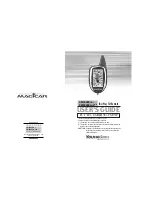
Operating instructions
22
Daikin RoCon
Daikin Control unit
008.1543999_00 – 03/2017 – EN
3
x
Operation
3.6.2 Heat slope
The heat slope is used to adjust the T-HS to the characteristics
of the building independent of the respective outside temperature
(weather-dependent T-HS control, see chap. 3.6.3). Generally
speaking, the steepness of the heating slope describes the ratio
of the T-HS change to the external temperature change.
The heat slope is valid within the limits of the minimum and
maximum temperatures set for the respective heating circuit. The
room temperature measured in the occupied area may differ from
the desired room temperature; these deviations can be kept to a
minimum by installing a room thermostat or a room control.
The
control unit
is set at the
factory
in such a way that the
heat
slope
does
not independently adjust itself
during operation.
The
automatic heat slope adjustment
can be activated ([HC
Adaption] parameter)
if
the
outside temperature sensor
(RoCon OT1) and the
room control
(EHS157034) are
con-
nected
(see chap. 3.6.3).
Start conditions for automatic heat slope adjustment:
– Outside temperature < 8 °C
– Operating mode is automatic (I or II)
– Duration of the setback period is at least 6 h
If
no automatic heat slope adjustment
is activated, the heat
slope can be
manually
adjusted by
adjusting
the
[Heat-Slope]
parameter
).
Detailed explanations and possible setting values of this function can be found in
chap. 6.2.
Caution – Risk of overheating of
floor heating!
In the event of malfunction or during manual
operation, the floor heating, the screed or the
floor structure could be damaged due to over-
heating.
●
Prior to initial commissioning, set the
maximum temperature limit in the RoCon BF
control unit ([Max T-Flow] parameter) to the
maximum permitted system temperature
prior to starting the emission measurement.
Manually adjusting the heat slope
Do not make any corrections to the set values for 1 - 2
days, and then only make them in small increments.
●
Deactivate the external heat sources (e.g. stoves, direct
sunlight, open windows).
●
Fully open any radiator thermostat valves or actuators.
●
Activate "Heating" operating mode.
Approximate setting values:
– Radiators and System 70: 1.4 to 1.6.
– Floor heating: 0.5 to 0.9.
Fig. 3-16 Manual setting of the heat slope
T
A
Outside temperature
T
R
Room temperature target val-
ue
T
V
T-HS
Fig. 3-17 Heat slopes
Configuration
Setup
System Configuration
Configuration
System Configuration
HC Configuration
DHW Configuration
HC Configuration
HC Function
Pump Mode
HC Configuration
Accep limit DHW
Heat-Slope
T-Flow Day
Heat-Slope
Heat-Slope
Heat-Slope
















































